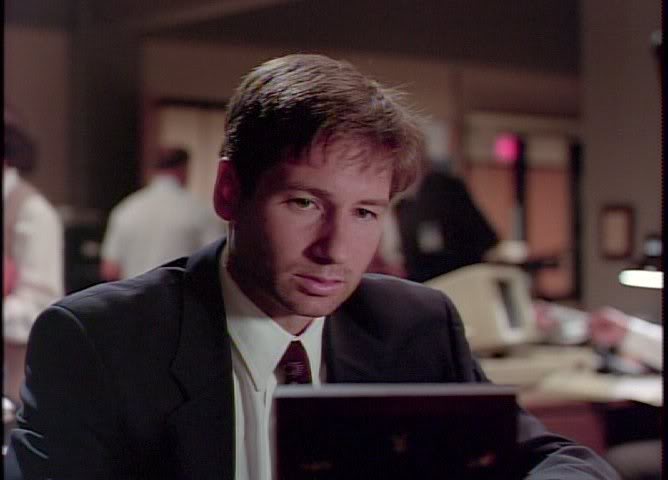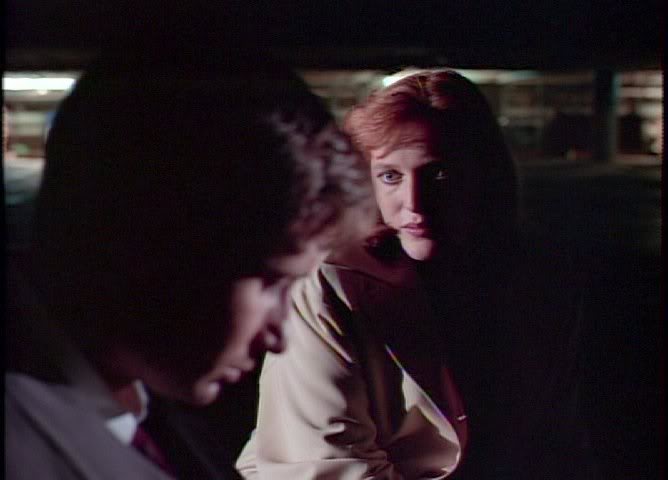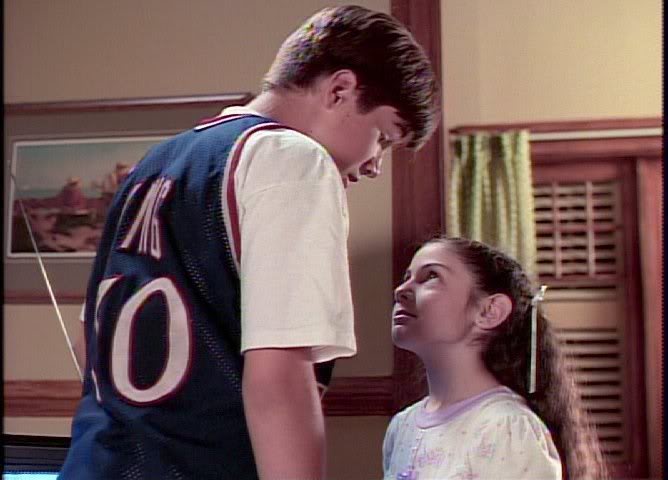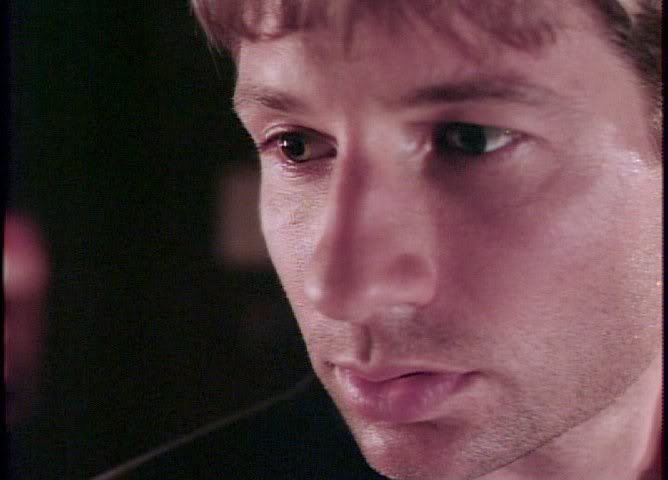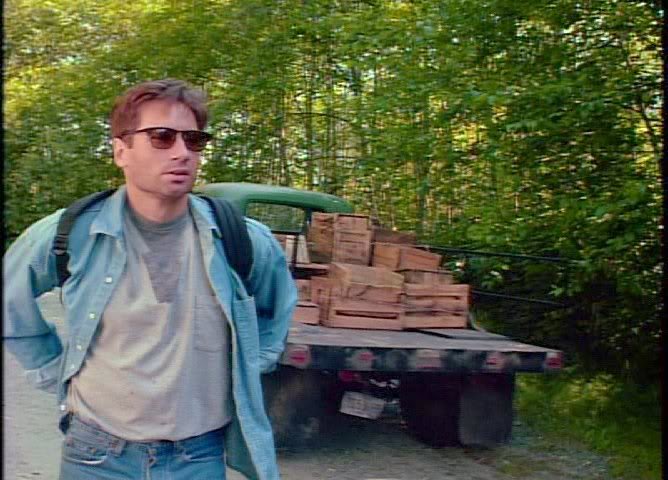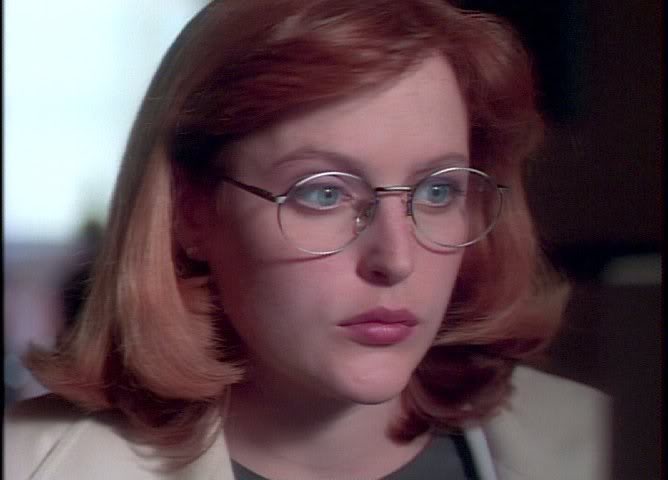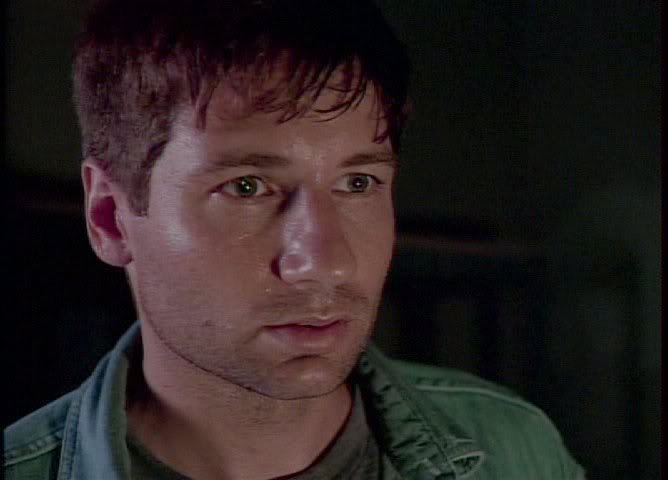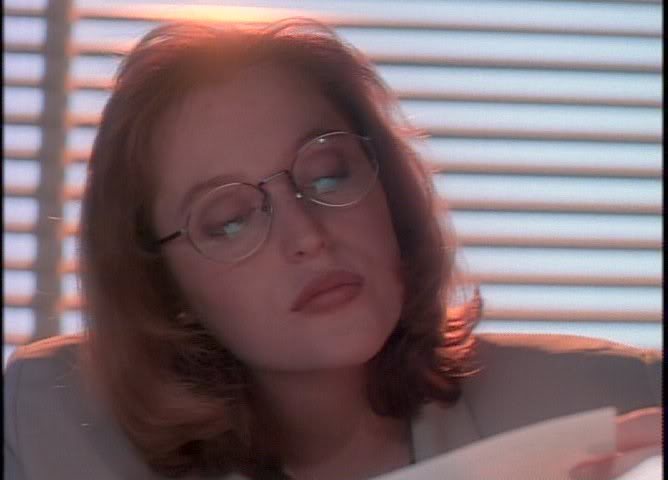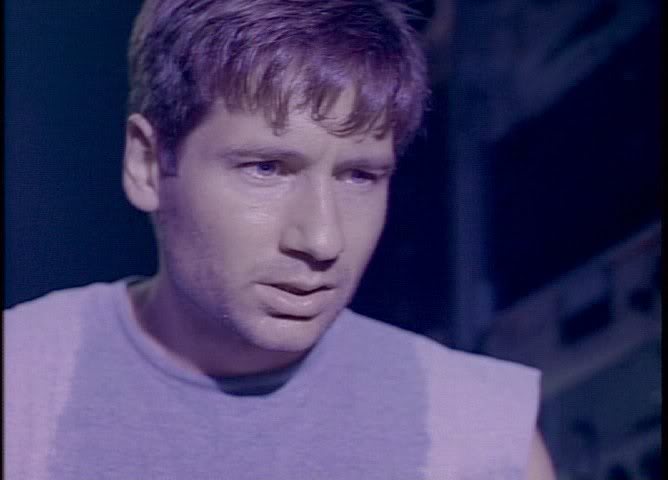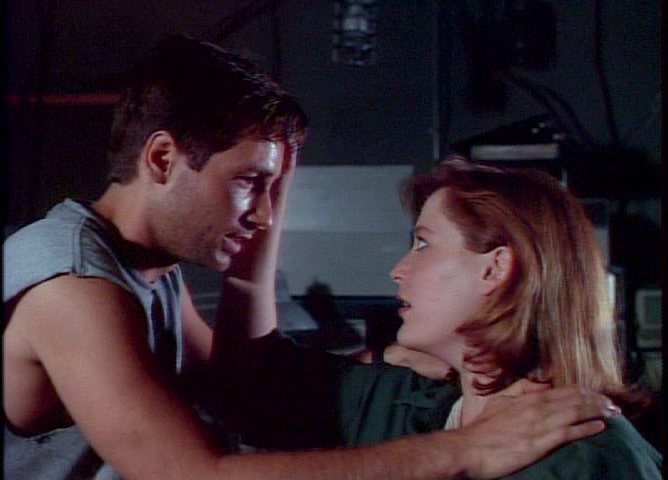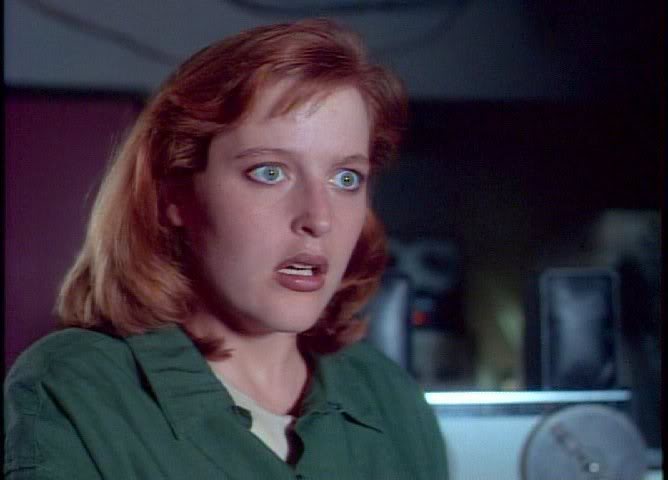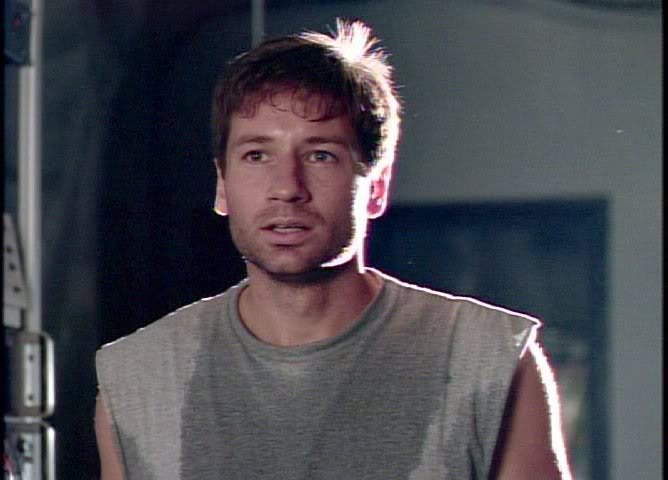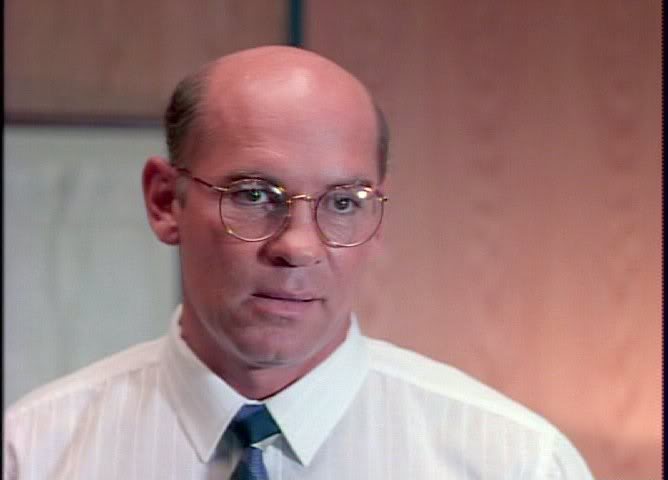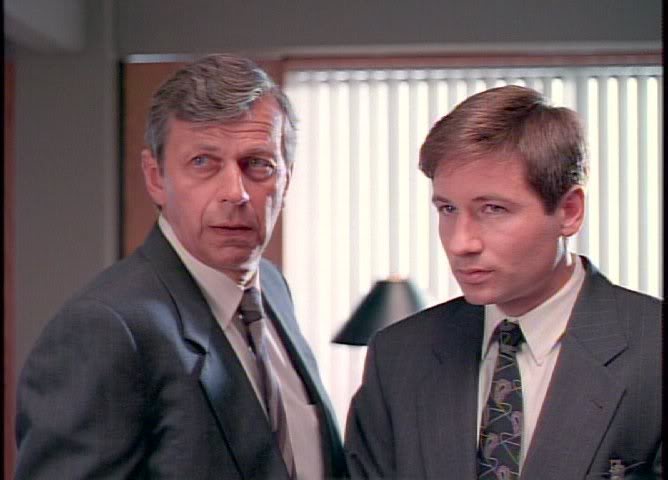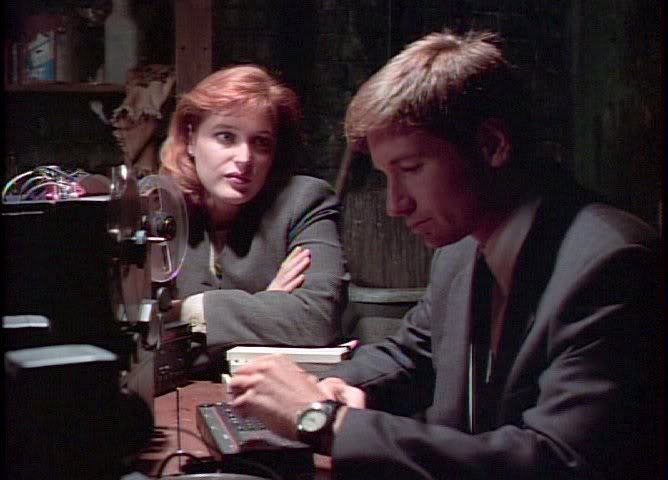REPOST -- CTP Episode of the Day - 04.10.06 - Little Green Men
Today's Cherished Episode: Little Green Men (2x01)
Original Air Date: September 16, 1994
Written By: Glen Morgan and James Wong
Directed By: David NutterWith the X-Files shut down, Mulder secretly journeys to a possible alien contact site in Puerto Rico while Scully tries to help him escape detection.
"I wanted to believe but the tools have been taken away. The X-Files have been shut down. They closed our eyes. Our voices have been silenced ... our ears now deaf to the realms of extreme possibilities."
Some "Little Green Men" Tidbits and Musings:
-- The episode title is a commonly used slang phrase for aliens from outer space. Mulder uses the phrase in the episode during his conversation with Scully in the Watergate garage.
-- Back in 1994, if The X-Files had been on another network, it's unlikely we would have seen "Little Green Men." The X-Files finished its first season ranked 113th out of 132 primetime series; and had it appeared on ABC, NBC, or CBS, the show probably wouldn't have been renewed for a second season. But it was on the fledgling FOX network, so the series got a chance to build an audience. The show's ratings improved gradually through April and May of its first season, and FOX increased promotion, which had lagged at the outset. The advertising department was instructed to push the "thrills and chills" aspect of the show, out of which grew the promotional line "Don't watch it alone."
-- Critical adulation also swelled during the first season with plaudits coming from such unlikely sources as The New Yorker which described the show as having "the makings of a classic," and "as scary as The Twilight Zone, and much sexier." With improving ratings and critical acclaim, FOX renewed the series for a second season and more people discovered the show during the summer of 1994, when certain episodes actually drew bigger audiences for repeat airings than their first showing.
-- "The show was really starting to expand beyond its boundaries of schedule and money," said director Rob Bowman about the start of Season 2. "And at that time we were just on the cusp of exploding into another kind of television show."
-- When the first season ended, Chris Carter and the series' other producers didn't know for sure whether the show would be picked up for a second season. But just in case, they included an important plot twist in the final episode of Season 1, "The Erlenmeyer Flask" -- shutting down the X-Files -- to address a situation they knew would have a significant impact on the beginning of a second season: the real-life pregnancy of Gillian Anderson.
-- "We made the decision to shut down the X-Files to allow for less screen time for Gillian during the first few second-season episodes," said writer/producer Glen Morgan. "Making a change like that was something you would normally do in a third year of a series. In a second season, historically, you take your concept and drive it home -- deliver what new viewers heard about the first season."
-- "Closing the X-Files -- something like that would usually be done to invigorate a series," added writer/producer James Wong. "Because we were doing it at the start of the second season, it gave us the challenge of trying to woo new audiences, while at the same time, trying to keep the old. We tried to do a good job of not changing that much; and in some ways, it gave us a fresh outlook on what The X-Files should or could be."
-- So the second season was set to begin with the X-Files closed and Mulder and Scully separated and reassigned. Carter's original premise for the season opener was to send Mulder to Moscow. Carter planned to write the script himself and tried to arrange to shoot some of the episode on location in Russia. But his idea for the episode didn't pan out, and plans for the location shoot fell through. At that point, Carter decided to ask Glen Morgan and James Wong to write the second season's first episode.
-- “It was a very nice gesture on Chris’ part in boosting our confidence and telling us how much he appreciated us,” Wong said. The two writers immediately decided that because the X-Files had been shut down, the second season opener "had to be kind of a new Pilot," Morgan said, "in the sense of altering the ground rules of the series."
-- "I really liked what they chose to do, which was simply taking something that had been established -- the idea that Mulder's sister possibly was abducted -- and using it in an interesting way," said Chris Carter. "They did something that made the best episodes really click. They took something that existed, something that was real -- Arecibo. They took the literature, if you will, of the search for extraterrestrials and wrapped it contextually around the Mulder and Scully story."
-- As indicated in Mulder's opening monologue, a pair of unmanned scientific probes, Voyager 1 and Voyager 2 were launched in 1977 to take advantage of a favorable planetary alignment of the late 1970s. Although they were officially designated to study just Jupiter and Saturn, the two probes were able to continue their mission into the outer solar system, eventually exiting the solar system. The probes were built at the Jet Propulsion Laboratory and were funded by NASA.
-- Voyager 1 and 2 both carried with them a golden record that contained pictures and sounds selected to portray the diversity of life and culture on Earth, along with symbolic directions for playing the record and data detailing the location of Earth. The record was intended as a combination time capsule and interstellar message to any civilization -- alien or far-future human -- that recovered either of the Voyager craft.
-- The contents of this record were selected by a committee chaired by Carl Sagan of Cornell University. Dr. Sagan and his associates assembled 115 images and a variety of natural sounds, such as those made by surf, wind, and thunder, and animal sounds, including the songs of birds and whales. To this they added musical selections from different cultures and eras, and spoken greetings from Earthlings in fifty-five languages, as well as printed messages from President Jimmy Carter and U.N. Secretary-General Kurt Waldheim (whose voice was heard in the excerpt played in the episode).
-- Carl Sagan noted, "The spacecraft will be encountered and the record played only if there are advanced space faring civilizations in interstellar space. But the launching of this 'bottle' into the cosmic 'ocean' says something very hopeful about life on this planet."
-- "This is a present from a small, distant world, a token of our sounds, our science, our images, our music, our thoughts and our feelings," said President Carter's official statement placed on the Voyager spacecraft. "We cast this message into the cosmos ... of the 200 billion stars in the Milky Way galaxy, some -- perhaps many -- may have inhabited planets and space faring civilizations. If one such civilization intercepts Voyager and can understand these recorded contents, here is our message: We are trying to survive our time so we may live into yours. We hope someday, having solved the problems we face, to join a community of Galactic Civilizations. This record represents our hope and our determination and our goodwill in a vast and awesome universe."
-- In addition to the first movement of Bach's Brandenburg Concerto No. 2 in F Major and many other pieces of music from around the world, the Golden Record contained Beethoven's Fifth Symphony (First Movement), a Night Chant by Navajo Indians, "Dark Was the Night, Cold Was the Ground" by Blind Willie Johnson, "Melancholy Blues" by Louis Armstrong and his Hot Seven, and "Johnny B. Goode" by Chuck Berry. Also included within the Sounds of Earth audio portion of the Golden Record was a track containing the inspirational message ad astra per aspera in Morse Code. Translated from Latin, it means through hardships to the stars.
-- Carl Sagan had originally asked for permission to include "Here Comes the Sun" from the Beatles' album Abbey Road. While the Beatles approved the request, their record label EMI opposed it and the song was not included.
-- The tape that Mulder was transcribing in Act 1 included the line, "Well, anyway, she’s onstage dancing to that Offspring song, 'Come Out and Play'." The Offspring was an American punk/rock band from California that was founded in 1984. The song "Come Out and Play" was the first single off their second album released in 1994.
-- In the original shooting script, Scully's autopsy scene in the first act is longer than in the episode as aired. The scene as it appeared in the script is transcribed at the end of this CTP.
-- Mulder and Scully's covert rendezvous at the Watergate Hotel was shot at the Plaza of Nations' underground parking facility in Vancouver.
-- The flashback scene where Samantha Mulder was abducted was different from Mulder's initial reminiscence of that event in "Conduit." In the first version, Mulder and Samantha were asleep in their beds, not awake playing a board game, at the moment she was taken. According to Chris Carter, because Mulder's memories were derived from regression therapy, those images were understandably vague, explaining why he would recall the incident differently at a later time.
-- In typical fashion, Glen Morgan explained the continuity error a little more honestly: "We don't watch the shows over and over."
-- Oopsie! In the 1973 abduction flashback, 12-year-old Fox Mulder was wearing a replica #30 Bernard King New York Nets jersey. Only problem was Bernard King didn't enter the league until 1977 (drafted 7th overall in the 1977 NBA draft by the New York Nets who months later relocated to New Jersey). King joined Fox Mulder's favorite team -- the New York Knicks -- in 1983.
-- Fox and Samantha were shown playing a game of Stratego when she was abducted. Stratego is a strategic board game featuring a 10 by 10 square board and two players with 40 pieces each. Pieces represent individual officers and soldiers in an army. One player uses red pieces and the other uses blue pieces. Players may arrange their 40 pieces in any configuration on a designated 4 by 10 section of the playing board. Such pre-play distinguishes the fundamental strategy of particular players, and largely influences the outcome of the game. The object of the game is to find and capture the opponent's Flag, or to capture so many pieces that the opponent cannot move at all. The modern game, with its Napoleonic imagery, was originally published in the Netherlands by Jumbo, and was licensed by the Milton Bradley Company for American distribution. The game was first issued in the U.S. in 1961.
-- The show that young Fox wanted to watch at 9 p.m. on the night his sister was abducted was The Magician, (one of Chris Carter's favorite shows when he was a teenager). It was a short-lived NBC television series that ran during the 1973-74 TV season, and told the story of stage illusionist Anthony Blake who used his magic skills to solve crimes. The series starred Bill Bixby as Anthony Blake. Under the tutelage of magician Mark Wilson, Bixby learned to do all the magic tricks used on the show; no trick photography was used.
-- The show's writers and producers may not have been able to keep the details of her abduction straight, but they did seem to pay attention to other details. On the night Samantha Mulder was abducted, Tuesday, November 27, 1973, the seventh episode of The Magician, "Lady in a Trap," aired at 9 p.m. on NBC.
-- The gun that young Fox got from the locked box in the flashback appeared to be the same gun that Mulder got from his father's trunk in "The Blessing Way."
-- In the series' first episode, Mulder referred to having "connections in Congress," and Senator Matheson represented the audience's first glimpse at one of those contacts. As far as the casting of that role, "we really wanted that to be Darren McGavin," Glen Morgan admitted. The producers also tried unsuccessfully to feature The Night Stalker star as Mulder's father, which Chris Carter deemed him to be in a symbolic way, based on the inspirational role that the earlier series played in creating The X-Files. McGavin eventually agreed to guest on the show in Season 5's "Travelers," playing the first FBI Agent interested in the "X" Files, Arthur Dales.
-- Senator Richard Matheson was named for fantasy, horror, and science fiction author and screenwriter Richard Matheson. Matheson wrote many short stories and novels, and he became a screenwriter adapting many of his works for the big and small screen. He wrote the screenplays for the films The Incredible Shrinking Man, Somewhere In Time, and The Legend of Hell House,, all adapted from his own works, as well as for the acclaimed TV movie Duel, adapted from his own short story -- which also happened to be Steven Spielberg's feature-length directing debut (the movie was shown on American television and released to cinemas in Europe).
-- Matheson also wrote a number of episodes for the original Twilight Zone -- including the famous "Nightmare at 20,000 Feet" (adapted from his short story Alone by Night) which starred William Shatner and was directed by Richard Donner. He also wrote episodes of Have Gun, Will Travel, Night Gallery, and Star Trek.
-- In 1973, Matheson earned an Edgar Award from the Mystery Writers of America for his teleplay for The Night Stalker, one of two TV movies written by Matheson that preceded the series Kolchak: The Night Stalker, which served as inspiration for The X-Files.
-- Originally, the opening monologue of "Little Green Men" was to have been recited by Senator Matheson.
-- In this and many other early X-Files episodes, Simon Fraser University was used to simulate the exterior of FBI Headquarters in Washington, D.C.
-- After writing the first season episode "E.B.E.," in which Deep Throat confessed a past crime of killing an alien to Mulder, Morgan and Wong intended to explore the character of Deep Throat more fully. They talked about writing an episode with Scully investigating Deep Throat in an effort to find a missing Mulder, or a story involving the government's Search for Extraterrestrial Intelligence (SETI) project. But those ideas went up in smoke when Deep Throat was killed at the end of Season 1. "Killing Deep Throat was Carter's idea," admitted Glen Morgan. "That was a tough hole to fill. Jerry Hardin was very good."
-- Morgan and Wong incorporated a bit of both those ideas into "Little Green Men," with Mulder traveling to the SETI installation at Arecibo, Puerto Rico, hoping to find evidence of extraterrestrials. "I always wanted to do something with the SETI background," Glen Morgan said. "I hoped that kids at school would check out SETI, because it was factual as to what existed." But the episode was about more than the SETI program. With Mulder undergoing a crisis of self-doubt, wondering if he had been chasing illusions, Morgan said one of the themes he and Wong wanted to convey was "the idea that we all have to fight our own little green men and carry on."
-- The Arecibo Observatory had its origins in an idea of Professor William E. Gordon, then of Cornell University, who was interested in the study of the Ionosphere. Construction of the Observatory began in the summer of 1960; and three years later, the Arecibo Ionospheric Observatory was in operation under the direction of Gordon.
-- The Observatory's radio telescope is the largest single-dish radio telescope ever to be constructed. The huge "dish" is 305 meters (1000 feet) in diameter, 167 feet deep, and covers an area of about 20 acres. The giant size of the reflector is what makes the Arecibo Observatory so special to scientists. It is the largest curved focusing antenna on the planet, which means it is the world's most sensitive radio telescope. Other radio telescopes may require several hours observing a given radio source to collect enough energy for analysis, whereas at Arecibo, this may require just a few minutes of observation.
-- The telescope is visually distinctive and has been used in the filming of two notable motion pictures: as the villain's antenna in the James Bond movie Golden Eye and as itself in the Jodie Foster film Contact.
-- The origins of SETI go back to the 1950s; but the project gained respectability -- and funding -- when NASA became involved in the 1970s. As Mulder mentioned in the monologue, on October 12, 1992 -- 500 years to the day after Columbus landed in the New World -- two NASA searches were launched. The Ames search began to scan its 800-1000 targeted stars from the radio telescope in Arecibo; and the JPL program began mapping the skies using the 34-meter dish at the Deep Space Communications Complex in Goldstone in the Mohave Desert. The searches were also given a new NASA designation -- High Resolution Microwave Survey (HRMS).
-- As Mulder also mentioned in the monologue, less than one year after their launch, both searches were suddenly and irrevocably terminated, victims of a new wave of Congressional budget cuts. Senator Richard Bryan of Nevada led the charge against governmental expenditures on SETI. "The Great Martian Chase," he said, "may finally come to an end. As of today millions have been spent and we have yet to bag a single little green fellow. Not a single Martian has said 'take me to your leader,' and not a single flying saucer has applied for FAA approval."
-- After an investment of around $60 million over 23 years, and less than one year of operation, NASA's SETI project was unexpectedly dead. Despite the crushing disappointment to SETI enthusiasts, the HRMS did not die in vain. The enormous resources available to NASA supported remarkable technological advances, which would have been very difficult to achieve without such backing. Further, much of the equipment used in the Ames targeted search was passed on to the privately funded SETI Institute, which then launched its own targeted search, the ongoing and aptly named "Project Phoenix" which is based on Arecibo.
-- Vancouver's Seymour Demonstration Forest doubled for the area around Arecibo, Puerto Rico.
-- "Little Green Men" was the first time viewers saw Scully use her key to enter Mulder's apartment.
-- According to Glen Morgan, the message on Mulder's answering machine from a woman he stood up for lunch was added "to show that Mulder wasn't a monk."
-- The episode revealed Mulder's computer password to be "trustno1," the last words spoken by Deep Throat in the Season 1 finale.
-- After Mulder found Jorge in the Arecibo control room lavatory, he asked Jorge, "Why are you so afraid? What have you seen?" Jorge responded in Spanish, and his translated answer was: "Lights in the sky. Red, blue, orange. I thought it was an airplane that had to go through the trees. But when I got there ... I saw men ... like animals ... but not men. They took me and put me here. They’re still out in the woods!"
-- 1013 Reference: The number 1013 showed up repeatedly in a column of the computer printout Scully took from Mulder's apartment.
-- In the March 1955 issue of Scientific American, Dr. John Kraus, Professor Emeritus and McDougal Professor of Electrical Engineering and Astronomy at the Ohio State University (OSU), described a concept to scan the cosmos for natural radio signals using a flat-plane radio telescope equipped with a parabolic reflector. Within one year, his concept was approved for construction by OSU. The 360-feet wide, 500-feet long, and 70-feet high telescope was powered up in 1963 and was called "Big Ear." Later, it began the world's first continuous SETI program.
-- The OSU SETI program gained fame on August 15, 1977. As Big Ear was searching the skies for an alien signal, its observations were being recorded on a printout sheet: a long list of letters and numbers was continuously being churned out, one long list for every one of the fifty channels scanned by the telescope. A list of characters appeared recording an unusual transmission at the frequency of channel 2: "6EQUJ5." This startled Big Ear volunteer, astrophysicist Jerry Ehman, a professor at Franklin University in Columbus, who was monitoring the readings that night. He circled the code for later reference and added a single comment in the margins: "Wow!"
-- Dubbed the "Wow Signal," it was considered by some to be the most likely candidate from an artificial, extraterrestrial source ever discovered, but it has not been detected again in several additional searches.
-- The passenger manifest that Scully scrutinized while trying to trace Mulder's movements contained the names of many on-line X-Philes at the time: Paulette Alves, Donald Anglin, Sylvia Bartle, Kinh Berreman, Sarah Brice, Kelly Brown, Tere Carstensen, Gail Celio, Cliff Chen, Hayden Dawson, Lori Dawson, Harle Erickson, Garn Ferguson, Jodi Giannini, Jan Gompf, Pat Gonzales (keeper of the X-Files FAQ), Jeff Gostin, Charles Grant (X-Files novel author), Betty Grant, Andrew Harrison, Melissa Harris, Linda Lee Hill, Scott Hill, and Eliza Hofmann.
-- The list also contained the name George E. Hale (which Scully recognized as Mulder's pseudonym). As Mulder mentioned earlier in the episode, astrophysicist George Ellery Hale was best remembered for his ability to put together financing and technical teams needed to produce large and effective telescopes. His first success was the Yerkes telescope at the University of Chicago, followed by two telescopes built for the Mt. Wilson Observatory in California. But Hales' biggest success was the 200-inch telescope built for the Mt. Palomar Observatory in San Diego, California. The telescope, which was named for Hale and dedicated in 1948, remained the greatest telescope on earth until 1993 when the Keck 1 superseded it in size and resolving power.
-- Scenes of Scully at the Miami International Airport were filmed at the Plaza of Nations B.C. Enterprises Building.
-- At the airport, Scully was pretending to read the Miami Herald, but if you look carefully you can see that she was actually reading the Facts And Arguments page from Canada's national paper, The Globe and Mail.
-- To me, the most important revelation in this episode was when Mulder was dictating into his tape recorder. Viewers assumed he was making notes to himself until he said, "My God, Scully. It's as if he's been frightened to death." He was talking to her, gathering evidence because of her -- because he learned the importance of that from her.
-- Mulder also said into his tape recorder, "Before I could only trust myself. Now I can only trust you ... and they've taken you away from me." Scully's importance in Mulder's life was cemented in "Little Green Men." Without this episode, the Scully abduction arc would not have had the power and the poignancy that it did. After "Little Green Men," we were sure how much Scully meant to Mulder, how much he depended upon her, and how her abduction devastated him to the core.
-- "Showing an actual alien was something that I wanted to resist doing until later in the show," said Chris Carter. "But this seemed a good time to do it."
-- "Chris believed strongly in mining the power of the imagination," said visual effects producer Mat Beck, "and that's what we did, not only in the scripts but visually and with a visual gag. The first time we actually showed an alien, in 'Little Green Men,' we actually shot in a wide doorway, and then shrunk it down so the doorway looked the right size and the alien looked really skinny."
-- During an appearance with Conan O'Brien, Gillian Anderson recalled that when they were filming the final scene set in Puerto Rico, with Mulder and Scully escaping the Blue Berets, the actors had to pretend to shoot their guns with their own sound effects (as in "Bang, Bang!" and "Pit-choo! Pit-choo!"). She said it was very hard to focus and not burst out laughing.
-- Mulder had a number of "father figures" in the show's early going; he described his relationship with Deep Throat as "dutiful son" and apologized to Senator Matheson for "letting him down." But Skinner is presented as the most important father figure in "Little Green Men," first scolding, then protecting Mulder, as any good father would do.
-- Mitch Pileggi also saw his role as a paternal one, even though he wasn't that much older than Mulder and Scully. "Jim Wong helped me get a handle on the character," Pileggi said. "He told me that Skinner was pretty much somebody who at one time had been in the same place as Mulder was. He was a field special agent, and worked his way up through the ranks, to that bureaucratic position. So he felt protective of Mulder and Scully, even though he sometimes had to protect them behind the scenes. But he was a bit like the stern father with the disobedient son sometimes, wasn't he?"
-- Skinner was first seen in the Season 1 episode "Tooms" and was asked to come back for the second season in part because of Gillian Anderson's pregnancy. "They needed to take the show in a different direction while they were dealing with Gillian's pregnancy," said Pileggi. "There was a lot of government intrigue stuff going on at that point, so I was brought in to compensate for her situation. And then the character just started clicking and working, and they were happy with what was going on, so they said they wanted me to keep coming back."
-- "A lot of my father seeped into the character," Pileggi said. "I didn't do it intentionally, it just happened, and I wasn't even aware of it until it was pointed out to me by my family. I didn't really think about it until I was watching one episode and it was like -- oh man, that's my dad. Sadly, my dad passed away before I started doing The X-Files, because he would have loved being around for it."
-- "The writers did a good job of keeping several different tensions going, with three different storylines working at the same time in this episode," said Chris Carter of "Little Green Men." "They kept it good and taut and that made it a good season opener and a great way to launch into Season 2."
-- FOX executives were not happy with the episode at first viewing, and tried to get Carter to scrap the whole thing and start over. Carter fought for the episode and eventually won.
-- Once & Future Retreads: Raymond J. Barry (Senator Richard Matheson) played the same role in "Nisei" and "S.R. 819." Les Carlson (Dr. Troisky) was Dr. Spitz in "Born Again." Vanessa Morley (Young Samantha Mulder) played the same role in "Herrenvolk," "Paper Hearts," "Memento Mori," and "Demons." Fulvio Cecere (Senator Matheson's Aide) was a Priest in "Revelations." Deryl Hayes (Agent Morris) was Webster in "Shadows" and an Army Doctor in "The Walk." Dwight McFee (The Commander) was David Gates in "Shapes," a Suspect in "Irresistible," and Detective Havez in "Clyde Bruckman's Final Repose." Lisa Ann Beley (Student) was Beatrice Salinger in "Miracle Man." Gary Hetherington (Lewin) was Kennedy in "Squeeze." Bob Wilde (Rand) appeared in uncredited roles in "Roland" (Detective), "Anasazi" (FBI Agent), "Nisei" (Limo Driver), and "All Souls" (George Vincent Dyer).
-- Following is the original autopsy scene from the shooting script. It is a bit longer than what ended up in the episode.
~ ~ ~ ~ ~
ACT ONE
INT. FORENSIC LABORATORY - DAY - CLOSE - TAPE PLAYER
The tiny wheels of an audio micro-cassette turn.
SCULLY: It is advantageous to begin an autopsy with removal of the cranium.
CAMERA BEGINS TO MOVE along a line of a half dozen notebooks and clipboards and tape recorders. One notebook indicates "Forensic Pathology. Instructor: Scully." A legend appears, "FBI ACADEMY, QUANTICO, VIRGINIA."
Observations crucial to the examiner's sense of smell will not be interfered with by internal odors ...
CAMERA CONTINUES through the room. It is dim and cold in the lab. The only light is a surgical lamp over the dead subject, spine on a stainless steel table. Reflections and spill light are the only other source of illumination.
CAMERA PROCEEDS along a table cover with unsettling pathologist's tools. Saws. Knives. God knows what.
Once the scalp has been dissected from the skull, below the occipital lobes, the cranium is opened with a horizontal division an inch above the eyebrow ridges.
CAMERA SETTLES on a skull saw. A latex gloved hand picks it up, pulling it to the doctor's fact for examination. REVEALS DANA SCULLY in a lab coat. She places a pair of goggles over her eyes, then proceeds to the table. She places the saw over the subject's forehead. On the WHIR of the blade ...
HER STUDENTS
Even veteran police officers slightly grimace as the pitch of the saw becomes DEEPER and MUFFLED as it cuts into the skull. One young TRAINEE, face white, subtly turns and leaves the room. The saw becomes silent.
SCULLY
Unspecific weirdness and goo reflects in her goggles as she works on the subject. O.S., BONE CRACKS. She pauses.
CAMERA PUSHES IN on Scully ... as she stares past the subject, lost in thought.
HER STUDENTS
Sensing her distance, they look to one another, unsure. The leader of the group, DRISCOL, speaks up.
DRISCOL: Something wrong?
WIDER
Scully's eyes remain locked on the dead man. She seems to be almost speaking to herself.
SCULLY: What this man imagined. His dreams. Who he loved. Saw. Heard. Remembered. What he feared. Somehow it's locked in this small mass of tissue and fluid.
She finally looks to her students, who are lost.
STUDENT: Will that be on the exam?
Scully, returned to the professor mode, a bit embarrassed.
SCULLY: No, no, of course not.
The students laugh nervously. Driscol, totally unaware that what he is about to say had a double meaning ...
DRISCOL: Are you okay, Agent Scully? You kinda sounded a little "spooky."
She turns, defensive. Scully eyes them as they tense.
SCULLY: Turn off your tape recorders.
The students eye one another.
SCULLY: Turn them off. Put down your notebooks.
They do so, unsure. Scully removes her goggles. She studies her students in the spill light.
We can perform autopsies, like this. Study crime scenes. Follow paper trails. Gather empirical evidence and think we've completed our investigation.
She pauses. Scully gestures to the subject.
But we're not even halfway finished because we are dealing with the mind. Human minds. Criminal and victim. Each one, amazingly, frustratingly unique. Each mind capable of different reactions of motives, perceptions. Some minds see and hear things that aren't even there.
She looks to the body on the table.
We can cut open the brain, but that doesn't get us inside the mind.
She studies her students, sensing they get the point, but also there is an air of pupils feeling they've been chewed out and don't know why. Scully eases, sighs, returning to the table.
This subject has a hemorrhage in the left cerebral peduncle ...
The students once again pick up their notebooks and turn on their tape recorders.
SCULLY (V.O. CONTINUED): ... and another in the posterior right temporal lobe ...
CAMERA MOVES IN CLOSE, once again to the tiny spinning wheels of the micro-cassette.
~ ~ ~ ~ ~
-- In reviewing "Little Green Men," Sarah Stegall wrote: "If I had to introduce a newcomer to this show, someone who had no idea what the series was about or what its special appeal was, this is the episode I would choose. Everything is here -- the search for proof of alien contact, the heartbreak over Mulder's sister Samantha, the understated sexual tension between Scully and Mulder, the quest Mulder has set himself, and the interference from the maddening Smoking Man and FBI bureaucrats. But most of all, we learn more about the enigmatic Agent Mulder himself in this episode than in any previous episode. It was high time: we'd learned the details about Samantha Mulder's abduction in 'Conduit,' learned of Scully's family life in 'Beyond the Sea,' even delved into Deep Throat's shadowy past in 'E.B.E.,' but heretofore we had not learned much about the man behind that badge."
-- "I found myself almost weeping for sheer pity at the conclusion of this masterpiece," continued Stegall. "Mulder is a much more human, much more believable character after we have seen his nightmares, his failures, his shattered hopes. I began to wonder what steel was in this man to make him pick himself up time and time again to go on in the face of repeated humiliation. This is a man doing penance for a lifetime, earning a graduate degree in patience."
-- I couldn't agree more. "Little Green Men" served as an outstanding "second pilot" for the series. A great story by Morgan and Wong, wonderful direction by David Nutter, excellent cinematography by John Bartley, and terrific acting by all involved, especially the understated, compassionate performance by David Duchovny.
-- "I may not have the X-Files, Scully, but I still have my work. And I've still got you. And I still have myself." And thankfully, so did we.
(Thanks to chrisnu for today's pics.)
Please share your first impressions, favorite (or cringe-worthy) moments, classic lines, favorite fanfic, nagging questions, repeated viewing observations, etc., as today we celebrate "Little Green Men."
Polly

